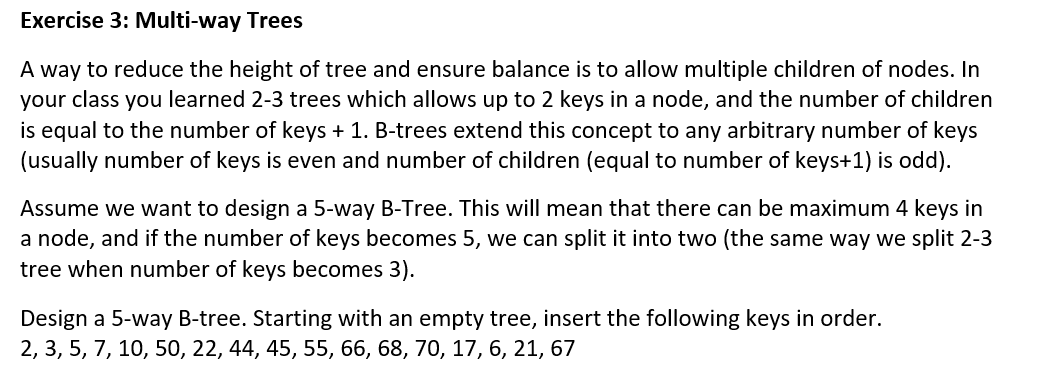Exercise 3: Multi-way Trees A way to reduce the height of tree and ensure balance is to allow multiple children of nodes. In your class you learned 2-3 trees which allows up to 2 keys in a node, and the number of children is equal to the number of keys + 1. B-trees extend this concept to any arbitrary number of keys (usually number of keys is even and number of children (equal to number of keys+1) is odd). Assume we want to design a 5-way B-Tree. This will mean that there can be maximum 4 keys in a node, and if the number of keys becomes 5, we can split it into two (the same way we split 2-3 tree when number of keys becomes 3). Design a 5-way B-tree. Starting with an empty tree, insert the following keys in order. 2.3.5. 7. 10. 50. 22. 44. 45. 55. 66. 68. 70. 17. 6. 21. 67
Exercise 3: Multi-way Trees A way to reduce the height of tree and ensure balance is to allow multiple children of nodes. In your class you learned 2-3 trees which allows up to 2 keys in a node, and the number of children is equal to the number of keys + 1. B-trees extend this concept to any arbitrary number of keys (usually number of keys is even and number of children (equal to number of keys+1) is odd). Assume we want to design a 5-way B-Tree. This will mean that there can be maximum 4 keys in a node, and if the number of keys becomes 5, we can split it into two (the same way we split 2-3 tree when number of keys becomes 3). Design a 5-way B-tree. Starting with an empty tree, insert the following keys in order. 2.3.5. 7. 10. 50. 22. 44. 45. 55. 66. 68. 70. 17. 6. 21. 67
Database System Concepts
7th Edition
ISBN:9780078022159
Author:Abraham Silberschatz Professor, Henry F. Korth, S. Sudarshan
Publisher:Abraham Silberschatz Professor, Henry F. Korth, S. Sudarshan
Chapter1: Introduction
Section: Chapter Questions
Problem 1PE
Related questions
Question

Transcribed Image Text:Exercise 3: Multi-way Trees
A way to reduce the height of tree and ensure balance is to allow multiple children of nodes. In
your class you learned 2-3 trees which allows up to 2 keys in a node, and the number of children
is equal to the number of keys + 1. B-trees extend this concept to any arbitrary number of keys
(usually number of keys is even and number of children (equal to number of keys+1) is odd).
Assume we want to design a 5-way B-Tree. This will mean that there can be maximum 4 keys in
a node, and if the number of keys becomes 5, we can split it into two (the same way we split 2-3
tree when number of keys becomes 3).
Design a 5-way B-tree. Starting with an empty tree, insert the following keys in order.
2, 3, 5, 7, 10, 50, 22, 44, 45, 55, 66, 68, 70, 17, 6, 21, 67
Expert Solution
This question has been solved!
Explore an expertly crafted, step-by-step solution for a thorough understanding of key concepts.
Step by step
Solved in 2 steps with 4 images

Knowledge Booster
Learn more about
Need a deep-dive on the concept behind this application? Look no further. Learn more about this topic, computer-science and related others by exploring similar questions and additional content below.Recommended textbooks for you

Database System Concepts
Computer Science
ISBN:
9780078022159
Author:
Abraham Silberschatz Professor, Henry F. Korth, S. Sudarshan
Publisher:
McGraw-Hill Education

Starting Out with Python (4th Edition)
Computer Science
ISBN:
9780134444321
Author:
Tony Gaddis
Publisher:
PEARSON

Digital Fundamentals (11th Edition)
Computer Science
ISBN:
9780132737968
Author:
Thomas L. Floyd
Publisher:
PEARSON

Database System Concepts
Computer Science
ISBN:
9780078022159
Author:
Abraham Silberschatz Professor, Henry F. Korth, S. Sudarshan
Publisher:
McGraw-Hill Education

Starting Out with Python (4th Edition)
Computer Science
ISBN:
9780134444321
Author:
Tony Gaddis
Publisher:
PEARSON

Digital Fundamentals (11th Edition)
Computer Science
ISBN:
9780132737968
Author:
Thomas L. Floyd
Publisher:
PEARSON

C How to Program (8th Edition)
Computer Science
ISBN:
9780133976892
Author:
Paul J. Deitel, Harvey Deitel
Publisher:
PEARSON

Database Systems: Design, Implementation, & Manag…
Computer Science
ISBN:
9781337627900
Author:
Carlos Coronel, Steven Morris
Publisher:
Cengage Learning

Programmable Logic Controllers
Computer Science
ISBN:
9780073373843
Author:
Frank D. Petruzella
Publisher:
McGraw-Hill Education